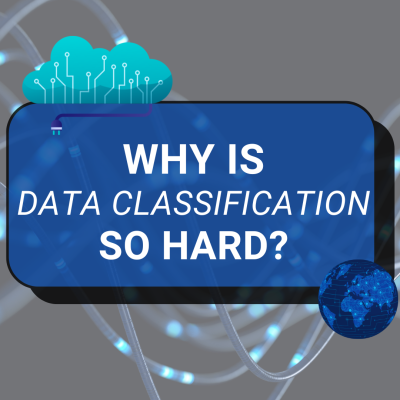In today’s digital landscape, organizations generate, store, and manage vast amounts of data across various platforms. While structured data in databases can be more easily categorized and protected, unstructured data—such as Word documents, PDFs, and Excel spreadsheets—poses a significant challenge. Data classification, which involves discovering, categorizing, and labeling these files appropriately, is a crucial component of data security and governance. However, achieving accurate classification at scale remains a formidable task.
Several key factors contribute to this challenge:
- Massive Scope
- Missing Intent
- Limited Context
- Temporal Considerations
Massive Scope: The Data Deluge
One of the fundamental reasons data classification is so difficult is the sheer volume of data being generated. As I have said, “Our ability to create data has far outpaced our ability to manage and secure it.”
Consider a financial services firm with 3,000 employees and over 1.5 billion files stored across file servers, SharePoint Online, and OneDrive. That figure doesn’t even account for additional data in cloud applications, databases, and personal computers. The idea of simply scanning and classifying all this information is daunting.
Even with automated tools, transmitting such a vast dataset over the network for analysis is time-intensive and resource-heavy. Cloud storage environments further complicate matters due to throttling limitations, which restrict how quickly files can be accessed and analyzed. Without a highly scalable, intelligent solution, organizations risk spending significant time and computing power on a never-ending classification process.
Missing Intent: Understanding the Purpose of Data
Automated data classification tools primarily rely on pattern matching and predefined rules to categorize data. However, they often lack the ability to interpret intent—the reason a document was created and how it is used. This limitation can lead to misclassification and unnecessary security alerts.
For example, imagine a document containing the word “password.” If this term appears in a training manual about secure password creation, the document is likely harmless. However, a rules-based classification tool may flag it as a security risk simply because it detects multiple instances of the word “password” alongside sample user IDs.
A human reviewer would immediately recognize the document as a training resource, but automated systems struggle to make such distinctions. Some modern solutions attempt to use machine learning and natural language processing to improve accuracy, but these technologies are still limited in their ability to understand true user intent.
Limited Context: The Business Relevance of Data
Even as data classification tools evolve, they still operate in a vacuum, meaning they analyze files in isolation without considering the broader business context. They can identify personally identifiable information (PII) such as credit card numbers or Social Security numbers, but do these automatically qualify as the most critical data to protect?
Organizations have unique priorities, and a company’s most sensitive information might not always be what classification tools flag as “high risk.” A financial institution may consider proprietary trading algorithms more critical than credit card numbers, while a law firm may prioritize case files over general employee data. Without input from business leaders and security teams, classification tools cannot accurately prioritize what matters most.
To highlight this gap, try asking a data classification vendor to identify the ten most important documents within an organization. The results will likely be arbitrary because tools lack the business intelligence to assess the strategic importance of files.
Some second-generation classification solutions leverage AI and large language models to improve contextual understanding. While these tools can better categorize data based on document content and relationships, they still cannot absorb an organization’s unique business objectives, making human oversight essential.
Temporal Considerations: Sensitivity Over Time
Another challenge in data classification is the shifting sensitivity of documents over time. The relevance and confidentiality of certain files change based on external factors such as market events, regulatory changes, or corporate actions.
Take an earnings report for a publicly traded company. Before the official earnings release, the document is highly confidential—any premature disclosure could lead to regulatory violations and market manipulation concerns. However, the moment earnings are publicly announced, the document’s classification shifts from “highly sensitive” to “publicly shareable.”
Today’s classification tools struggle to account for such temporal shifts. A document labeled “confidential” at one point in time may no longer warrant that classification after a business milestone. Similarly, outdated files containing once-sensitive information may no longer be a security risk, but classification tools typically apply static labels that don’t adjust as circumstances change.
This limitation underscores the need for dynamic classification policies that evolve alongside business events, rather than relying solely on rigid rules and automated scanning.
How to Overcome These Challenges
Despite the inherent difficulties, data classification remains a crucial component of a strong data security strategy. The key is to approach classification with realistic expectations and a well-rounded strategy that combines technology with human expertise.
- Acknowledge Limitations – Accept that no classification tool will be 100% accurate. Automated solutions can provide a baseline, but human oversight is essential to refine classifications and address ambiguities.
- Engage Business Stakeholders – Security teams should work closely with business leaders to identify the most critical data assets. Classification efforts should align with business priorities, not just generic risk indicators.
- Leverage AI and Machine Learning – While imperfect, AI-driven classification tools offer improvements over traditional rules-based systems. Investing in solutions that use natural language processing can improve accuracy and reduce false positives.
- Implement a Layered Approach – Rather than relying on a single classification tool, use a combination of technologies, policies, and human intervention to improve accuracy and adaptability.
- Establish Dynamic Policies – Data classification should not be a one-time process. Organizations need policies that allow classifications to evolve as business needs change. Regular audits and updates are essential to maintaining relevance.
- Focus on Governance Over Perfection – The goal is not flawless classification but rather a functional, risk-based approach that enhances data governance. “Perfect is the enemy of good” in this context—organizations should aim for practical improvements rather than an unattainable ideal.
Final Thoughts
Data classification is an invaluable tool for securing sensitive information, improving compliance, enabling AI solutions, and enhancing risk management. However, it is not a silver bullet. Organizations must approach classification projects with an understanding of their limitations, involve business stakeholders in decision-making, and leverage a mix of technology and human expertise.
By acknowledging the complexities and adopting a strategic approach, businesses can navigate the challenges of data classification more effectively. While perfect classification may never be possible, a well-executed classification program can still provide immense value in securing and managing corporate data.




